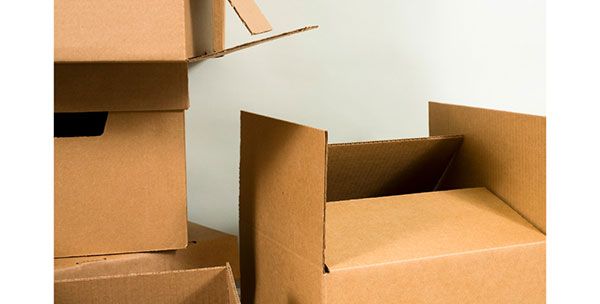It’s easy to get sidetracked by family photos … instead of shredding 15-year-old tax returns.
When you've moved 17 times in 18 years like Doug Levy, an emergency communications consultant in Corte Madera, California, you learn a few things about the practical and unexpected side of moving. First, there are the technical details, like finding and scheduling a reliable mover and getting the right size and number of boxes. “Those are the obvious things," says Levy.
Less predictable? The emotional details. "Going through everything you own churns up memories," he says. It's easy to get sidetracked by family photos and keepsakes or alphabetizing CDs instead of shredding 15-year-old tax returns.
Having friends around while he packed for his last cross-country move helped him stay focused. "Some friends actively helped pack boxes, but mostly they helped me stay on task packing, instead of wallowing in the memories."
Here, Levy and other frequent movers — both homeowners and professional packers — break down more moving tips starting six months before a move. Their experience (and one genius box labeling technique) can help make packing up a home and relocating a little easier.
Six months before move

Movers handle everything you own. How well do you know and trust them?
Conduct a basic background check on movers, the same way you would a contractor or any professional handling your property, says Pamela Mueller, co-owner of a moving planning company in New York City. Is the company fully insured? Does it have a good reputation with customers? "Get at least two references and actually speak to the customers — call and talk to them."
Questions to ask:
- Did the movers pack and move any high-value items, such as artwork, jewelry or vehicles?
- Were the movers professional and careful with your belongings?
- Did the movers show up on time, with the equipment and any other extras required for the move?
- Was anything damaged in the move? If yes, how did the moving company handle the claim?

Inventory high-value possessions, like artwork, antique cars and jewelry.
If you own items valued at $5,000 or more, and they're one-of-a-kind or fragile, talk to professional movers who specialize in moving fine art. "It's not worth it to take the chance of someone damaging it," says Mueller. "And once something is damaged, it loses its value."
Moving companies are liable for the value of the goods they move, according to the U.S. Department of Transportation Federal Motor Carrier Administration, but "valuation" coverage is not insurance. Movers are required to offer two options in valuation coverage:
Full value protection
The mover is responsible for repairing, replacing or paying for the entire value of a damaged item. Movers will charge an additional fee for this option.
Released value
The mover is responsible for no more than 60 cents per pound per item. (If a high-end 250-pound, $5,000 refrigerator is dropped and damaged beyond repair, the mover is only required to pay $150.) This option is available at no additional cost or fee, and you must sign a waiver on your bill of lading before the move.
Full value protection
The mover is responsible for repairing, replacing or paying for the entire value of a damaged item. Movers will charge an additional fee for this option.
Released value
The mover is responsible for no more than 60 cents per pound per item. (If a high-end 250-pound, $5,000 refrigerator is dropped and damaged beyond repair, the mover is only required to pay $150.) This option is available at no additional cost or fee, and you must sign a waiver on your bill of lading before the move.
Ask about hidden moving fees.
There's a long list of additional fees a mover may charge on top of the estimate you receive. After you've reviewed a quote, ask if the following charges may be added.
- Accessorial charges
- Advanced charges
- Appliance service
- Auxiliary service
- Customs clearance
- Elevator carry
- Expedited service
- Flight charge
- Line-haul charges
- Long carry
- Shuttle service
- Specialty movers
- Storage in transit
- Storage extension coverage
- Warehouse handling
- Accessorial charges
- Advanced charges
- Appliance service
- Auxiliary service
- Customs clearance
- Elevator carry
- Expedited service
- Flight charge
- Line-haul charges
- Long carry
- Shuttle service
- Specialty movers
- Storage in transit
- Storage extension coverage
- Warehouse handling

Reserve a move date. (Flexibility can save serious cash.)
Mueller says you're more likely to get your preferred date when you reserve early, and you may also get a break on the rate if the moving company offers discounts for early booking. When discussing your move date, ask if rates change based on the time of year or days of the week. Because home sales are highest in summer months and kids are on summer break, May through September is typically the most popular — and expensive — time to move.
When Levy relocated from New York to California in 2016, his flexibility in scheduling significantly affected rates. "By delaying my last cross-country move from September until December, I probably saved 30 percent on the long-haul moving expense."
Buy four big boxes.
Mark them "Keep," "Donate," "?" (for items you're unsure about) and "New Owner" (for things you might leave for the new homeowner). Mueller says this broad, gradual sorting starts the decluttering process early and whittles down the items you'll need to pack and move.
Moving rates are also based on the weight of the shipment. When you're considering what to keep and what to donate, Levy says it pays to think about which items are worth their weight. "If you have inexpensive furniture, it may be cheaper to discard, or sell it and buy new on the other end."
Three months before move

Categorize your possessions.
California resident Paula Katzenburg, whose husband works for a major airline company, has moved 20 times in as many years. She perfected what she calls the 3-2-1 method of prioritizing household items. These numbers divide a household into daily, essential items and the stuff a family can live without for weeks (or even months). On move-in day, unpack boxes marked “1” first. Boxes marked “2” and “3” have been packed for more than a month, which means they can wait a little longer to be unpacked, says Katzenberg.
- "A month before the move date, I look at what's left. Anything that isn't used daily is packed and labeled with the room name and the number 2."
- "As soon as I know we'll be moving, I pack anything I don't use on a monthly basis: books, knickknacks, tchotchkes and out-of-current-season clothing." She writes the room name and “3” on the box.
- Day-to-day essentials get boxed a day or two before the move and labeled with the number 1.

Buy small and midsize boxes in bulk.
"Movers typically charge a premium for single boxes," says Levy, who recommends buying boxes from a wholesale warehouse chain or a big home supply store.
"I used to collect boxes from liquor stores, but in New York City, it's too difficult to drag boxes on trains," says Annette Tomei, a chef who has moved 48 times, crisscrossing the country for her job. Tomei buys fresh boxes online by the dozen and has stockpiled clear plastic stackable bins, which are worth the extra expense. "They're more durable and I can see into them to grab what I need when I need it."
"Small or midsize boxes are best," says Carol Gee, an author, retired Air Force veteran and educator. She lost track of the number of moves (somewhere around 20), but as an avid reader and collector of books, she cautions against large boxes, which are too heavy to lift when packed full. Standard book boxes measure 16 x 12 x 12 inches; medium boxes are 18 x 18 x 16 inches.
Think twice about a storage unit.
Mueller calls them the black hole of forgotten items. "It's where you put things before you give them away," she says. "You pay rent every month, then five years later you have no idea what's in there. I encourage people to deal with what they have when they move."
If you're moving out but don't know where you're moving in, consider storing everything with your movers, says Tomei. "It's so much easier to build it into the original contract and have your stuff a phone call away when you're ready to have it delivered."
One month before move

Plan meals around what's in your pantry.
Inventory the pantry and freezer, then group items into possible meals you can cook before you move, says Julia Simens, a school counselor whose job has taken her family to five continents.

Consider a yard or estate sale.
"My husband calls it the Halfway to the Curb sale — nothing comes back into the house," says Crissy Perham, whose husband's position in the Air Force requires her family to pick up move frequently (10 moves and counting). A yard or estate sale can help you reduce the load of what you pack and pay to move, and it can put money back in your pocket to off-set moving costs.
Instead of unloading the rest at a charity thrift store, call around to find organizations in need of specific items. "Unwanted textiles can go to your local animal shelter. Donate books to a retirement home or school," says Perham, who makes drop-offs to several locations after her yard sale.
Two weeks before move

Pack all but the most necessary clothes.
Katzenberg favorite trick: insert all clothing on hangers into large garbage bags and pull the plastic drawstring closed around the neck of the hangers. It's an inexpensive way to protect clothing and keep it organized and labeled for easy unpacking.
Gather necessities and important documents that will travel with you.
"I always carried my marriage license, medical records, insurance papers, passports and things I couldn't afford to lose," says Gee. "I also pack a set of sheets, blankets, towels, a couple of pots and pans, and clothing items for the family. Little things, like paper plates, cups, plastic utensils and toilet paper, also come in handy in a move."
Don’t pack important paperwork in moving boxes. Carry essential documents (birth certificates, passports, marriage license, etc.) with you during the move.
Create a private family space that's off-limits to movers.
"This is where you put the travel suitcases and other necessities you want within easy reach during the move," says Simens. "Remember to include your electronics cords and chargers too."
Farmers Home Insurance
Find out why home
insurance from
Farmers is a smart
choice.
Get a quote
Includes personal service from a Farmers agent.
Written by
The information contained in this page is provided for general informational purposes only. The information is provided by Farmers® and while we endeavor to keep the information up to date and correct, we make no representations or warranties of any kind, express or implied, about the completeness, accuracy, reliability, suitability or availability with respect to this article or the information, products, services or related graphics, if any, contained in this article for any purpose. The information is not meant as professional or expert advice, and any reliance you place on such information is therefore strictly at your own risk.
Related articles




